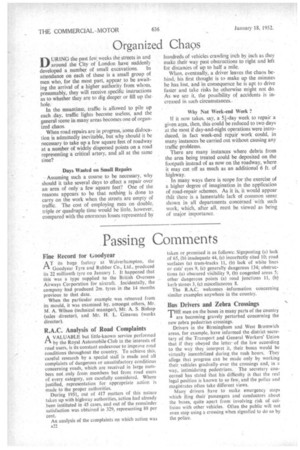Organized Chaos
Page 24

If you've noticed an error in this article please click here to report it so we can fix it.
URING the past few.weeks the streets in and around the City of London have suddenly developed a number of small excavations. In attendance on each of these is a small group of men who, for the most part, appear to be awaiting the arrival of a higher authority from whom, presumably, they will receive specific instructions as to whether they are to dig deeper or till up the • hole.
In the meantime, traffic is allowed to pile up each day, traffic lights become useless, and the general scene in many areas becomes one of organized chaos.
. When road repairs are in progress, some dislocation is admittedly inevitable, but why should it be necessary to take up a few square feet of roadway at a number of widely dispersed points on a road representing a critical artery, and all at the same time?
Days Wasted on Small Repairs Assuming such a course to be necessary, why should it take several days to effect a repair over an area of only • a few square feet? One of the reasons appears to be that nothing is done to carry on the work when the streets are empty of traffic. The cost of employing men on double, triple or quadruple time would he little, however; compared with the enormous losses represented by hundreds of vehicles crawling inch by inch as they make their way past obstructions to right and left for distances of up to half a mile.
When, eventually, a driver leaves the chaos be, hind: his first thought is to make up the minutes he has, lost, and in consequence he is apt to drive faster and take risks he otherwise might not do. As we see it, the possibility of accidents is increased in such circumstances., Why Not Week-end Work ?
If it now takes, say, a 5k-day week to repair a given area, then, this could be reduced to two days at the most if day-and-night operations were introduced, in fact week-end repair work could, in many instances be carried out without causing any traffic problems.
There are many instances where debris from the area being treated could be deposited on the footpath instead of as now on the roadway, where it may cut off as much as an additional 6 ft. of highway.
• In many ways there is scope for the exercise of a higher degree of imagination in the application of road-repair schemes. As it is, it would appear that there is a lamentable lack of common sense shown in all departments concerned with such work, which, after all, must be viewed as being of major importance.




















































































